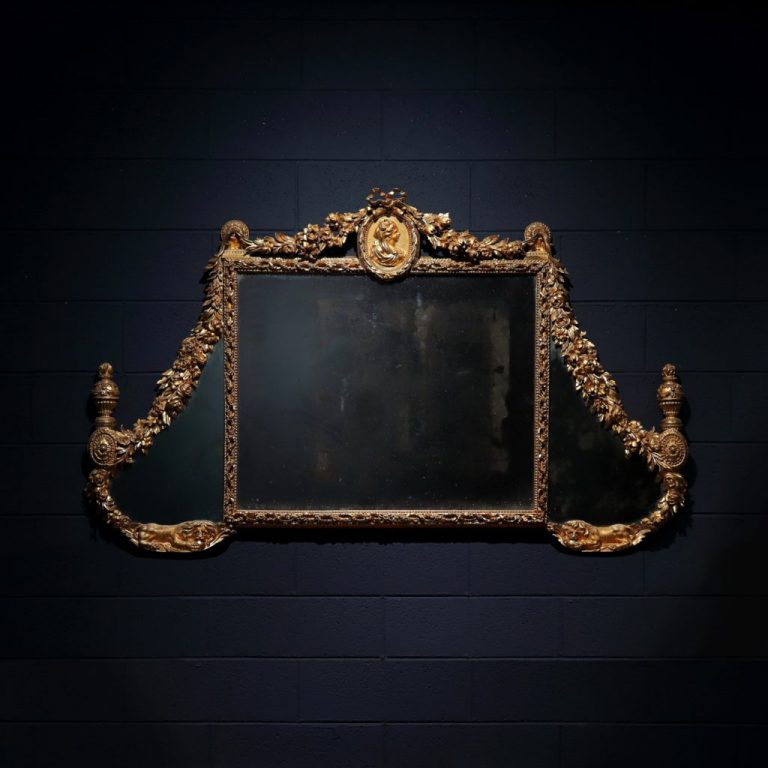Florence
Description:
Neoclassical fireplace or support mirror, richly and finely carved in lime wood and gilded.
The rectangular frame of the mirror,which is the main one, is made with a gouged frame with a ribbon motif on the back and beads inside; above the gouging, carved in the round, there is an interweaving between a ribbon and a floral wreath, a delicate, almost embroidered motif.
In the upper part of the frame there is a medallion which encloses the profile of a Diana in an oak wreath; from a tied ribbon two floral festoons start which are connected to two galls placed on the edges of the frame.
From here descend, with unusual invention, two large double-order festoons carved with an abundance of leaves and flowers among which there is a large quantity of roses; on these rest two rosettes with two vases that burn perfumes with flame. These two side frames are shaped like two wings resting on two lions; the lions are carved and housed in a leafy cradle and lie down and placid with a sphere between their paws. The animal support curve shows us the original accommodation in a boiserie and not in the two nineteenth-century gilded bases that now accompany it.
The mirrors of the neoclassical fireplace are mercury-filled, the leaf gilding with light and dark effects rendered with glossy and opaque, the effect is accentuated in the medallion with the engraving that makes the background surface rough and more opaque.
The woods used are lime for the construction and carved part, fir for the funds that protect the mercury mirrors.
Dimensions: 117 x 168 x 9 cm ( 46 x 66,1 x 3,54 in )
Historical-stylistic analysis:
The modernization work promoted by the Grand Duke Pietro Leopoldo (in Florence since 1765), will lead to the abandonment of the Tuscan late-Baroque taste for the more modern neoclassicism, inspired by Roman villas and those findings of Neapolitan excavations that were quickly conquering and fascinating all of Europe .
The Grand Duke’s choice to entrust the young Giocondo Albertolli with the ornate works of the palaces will prove decisive; the modernity and novelty of the artist’s works will be the first samples from which the new classic taste will draw inspiration.
It will be Pietro Leopoldo who advised his brother Ferdinando to hire Albertolli in Milan, where he will also be in charge of the direction of the chair of ornate at the Brera Academy.
The Florentine neoclassicism and that of Albertolli will not only look at Roman classicism, but will be positively influenced by the rereading that the Renaissance homeland had already given of the Roman stylistic canons in the fifteenth century.
To this historical-stylistic premise it should be added that Florence enjoyed the fortune, unlike cities like Milan, of having capable workers, coming from all over Europe, not only in stone and semi-precious stone works, but also in menusieri, in carvings, gilding , cabinetry etc.
Prestigious are the carving works published in the texts that contain the collections of Florentine palaces.
The shops mentioned in the inventories are numerous, the most prestigious undoubtedly that of Lorenzo Dolci (who succeeded his father Giovan Battista) but also Odoardo Wyndham, Carlo Toussaint etc.
In this regard, it must be said that the execution of the neoclassical mirror described here is of great quality, first of all in terms of invention, execution and finally of gilding. Particularly interesting is the all-round perforated interweaving that covers the frame and also the double ribbon carving of the floral festoon on the sides. Everything is done and finished with great care and attention, even in the upper part, up to the wall.
The medallion, like the vases with flame, place the furnishings in full neoclassical style, but with that Renaissance imprint given by the abundance of festoons.
It is therefore possible both a comparison with the consoles made by Giovan Battista Dolci, (now located in the Oval Cabinet of the Royal Apartments of Palazzo Pitti around 1667), and with the more neoclassical mirrors, look at that of Lorenzo Dolci (Camera del Re, district in winter, Palazzo Pitti, 1798).
Although without being able to attribute it to the same workshop, the stylistic analysis shows us how the abundance of carving and the invention bring back to the consoles of Lorenzo’s father, while the modalities, the festoons of roses, the medallion with burin bottom, the he use of animal figures move us to a more mature era of the new style.
For these reasons, I believe I can place the construction of the neoclassical fireplace in the last quarter of the eighteenth century.
Finally, a perhaps a little romantic thought; I seem to see in the design of this neoclassical mirror a tribute to the large baroque console with lions attributed to the execution by Paolo Monaccorbi based on a design by Foggini, at least the references of festoons and lions seem evident.
Bibliography:
– Enrico Colle, Il mobile Rococò in Italia, ed. Electa 2003
– Enrico Colle, Il mobile neoclassico in Italia, ed. Electa 2005
– Simone Chiarugi, Botteghe di Mobilieri in toscana, ed. S.P.E.S. 1994
– Alvar Gonzalez-Palacios, Il tempio del gusto, ed. Longanesi 1986
- Neoclassical fireplace

Antiques, Art and Design
FineArt is the new ambitious Di Mano in Mano project that offers an exclusive choice of antiques and design works, presenting them for their singularity and uniqueness.




